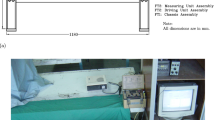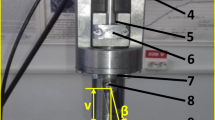Abstract
A testing machine was designed specifically to study fatigue behavior of molded polymeric materials by subjecting multiple cantilever specimens to vibratory fluid loading. The fluid loading permits aqueous or other environments, facilitates temperature control, and makes possible high testing frequencies. Samples of fifteen to thirty specimens may be tested simultaneously to obtain statistical data. Example results are presented showing Weibull distributions fitted to polymethyl methacrylate fatigue-life data. A statistical criterion was used to verify that scatter, due to the machine and testing technique, was not excessive.
Similar content being viewed by others
References
Gott, V. L., Daggett, R. L., Whiffen, J. D., Koepke, D. E., Rowe, G. G., andYoung, W. P., “A Hinged-Leaflet Valve for Total Replacement of the Human Aortic Valve,”Jnl. Thoracic Cardiovascular Surg.,48 (5),713–723 (1964).
“Tentative Method of Test for Repeated Flexural Stress (Fatigue) of Plastics,” ASTM D671-51T, ASTM Standards, Pt. 9, 364–375 (1961).
Telfair, D., Adams, C. H., andMohrman, H. W., “Creep, Long-Time Tensile, and Flexural Fatigue Properties of Melamine and Phenolic Plastic Materials,” Trans.ASME,69,789–793 (1947).
Lazar, L. S., “Accelerated Fatigue of Plastics,” ASTM Bulletin No. 220, 67–72 (1957).
Zarek, J. M., “Accelerated Fatigue Testing of Polymethyl Methacrylate,”Brit. Plas., 30, 399 (1957).
Pusey, B. B., “Flexural Fatigue Strengths of Reinforced Thermosetting Laminates,”Plas. Technol.,3 (9),721–726 (1957).
Hagerup, E., “Flexural Fatigue Testing of Polyesters,”Jnl. Appl. Polymer Sci.,7 (3),1093–1116 (1963).
Findley, W. N., “New Apparatus for Axial-Load Fatigue Testing,” ASTM Bulletin No. 147, 54–56 (1947).
Boller, K. H., “Resume of Fatigue Characteristics of Reinforced Plastic Laminates Subjected to Axial Loading,”Fatigue-An Interdisciplinary Approach, Syracuse Univ. Press, Syracuse, N. Y., 325–341 (1964).
Carey, R. H., “Fatigue Testing of Nonrigid Plastics,” ASTM Bulletin No. 206, 52–54 (1955).
Lake, G. J., andLindley, P. B., “The Mechanical Fatigue Limit for Rubber,”Jnl. Appl. Polymer Sci.,9,1233–1251 (1965).
“A Guide for Fatigue Testing and the Statistical Analysis of Fatigue Data,” ASTM Spec. Tech. Publ. No. 91-A (1963).
Johnson, L. G., “The Statistical Treatment of Fatigue Experiments,”Elsevier Publishing Co., New York, N. Y. (1964).
McClintock, F. A., “A Criterion for Minimum Scatter in Fatigue Testing,”Jnl. Appl. Mech., 22, 427–431 (1955).
Author information
Authors and Affiliations
Rights and permissions
About this article
Cite this article
Pringle, O.A., Harker, R.J. Environmental fatigue testing of molded plastics for prosthetic heart valves. Experimental Mechanics 9, 171–178 (1969). https://doi.org/10.1007/BF02326566
Issue Date:
DOI: https://doi.org/10.1007/BF02326566




